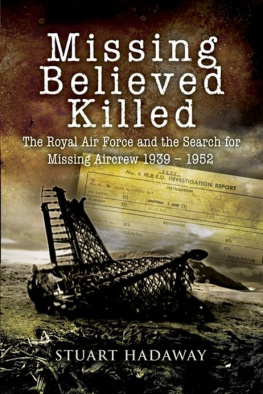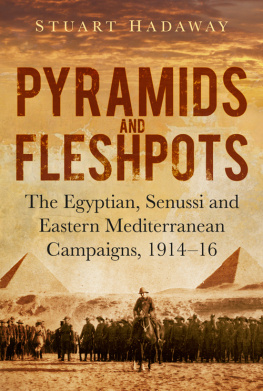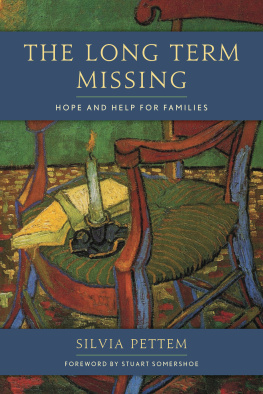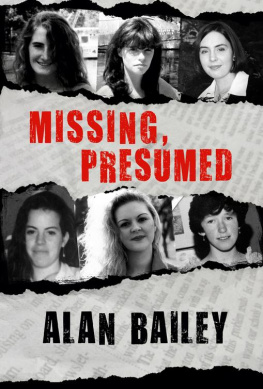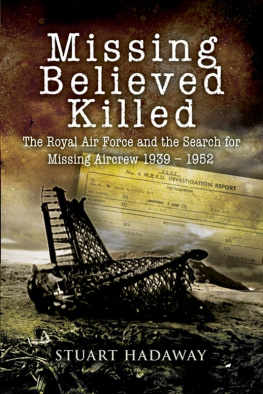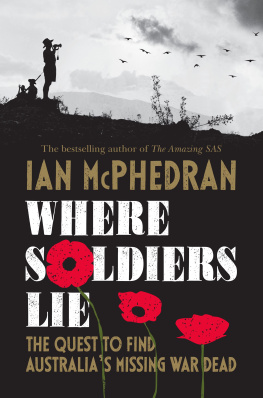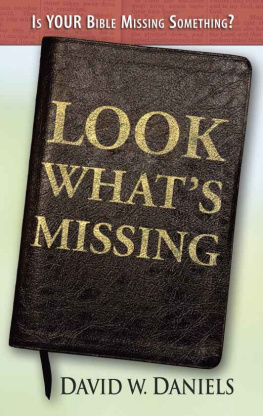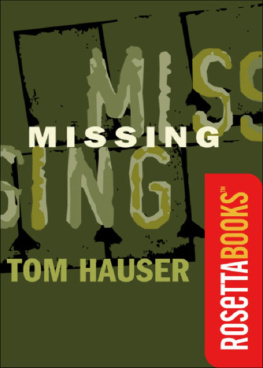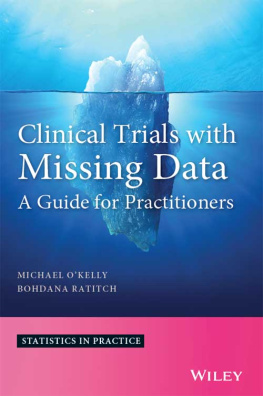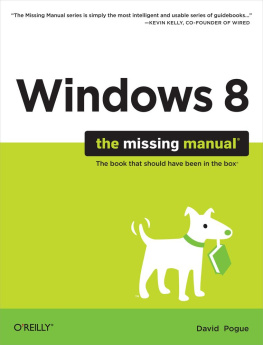For those who never came back and all those who went to look for them

First Published in Great Britain in 2008 by
Pen & Sword Aviation
an imprint of
Pen & Sword Books Ltd
47 Church Street, Barnsley, South Yorkshire S70 2AS
Copyright Stuart Hadaway, 2008
9781844684472
The right of Stuart Hadaway to be identified as author of this work
has been asserted by him in accordance with the Copyright,
Designs and Patents Act 1988.
A CIP catalogue record for this book is
available from the British Library.
All rights reserved. No part of this book may be reproduced or transmitted in
any form or by any means, electronic or mechanical including photocopying,
recording or by any information storage and retrieval system, without
permission from the Publisher in writing.
Typeset in 10/12pt Palatino by
Concept, Huddersfield
Printed and bound in England by
Biddles Ltd
Pen & Sword Books Ltd incorporates the Imprints of Pen & Sword Aviation,
Pen & Sword Maritime, Pen & Sword Military, Wharncliffe Local History,
Pen & Sword Select, Pen & Sword Military Classics and Leo Cooper.
For a complete list of Pen & Sword titles please contact
PEN & SWORD BOOKS LIMITED
47 Church Street, Barnsley, South Yorkshire, S70 2AS, England
E-mail: enquiries@pen-and-sword.co.uk
Website: www.pen-and-sword.co.uk
Acknowledgements
T his book has not been the easiest to write, and there are many people without whom it simply would not have been possible. My father, David Hadaway, to whom this book is most respectfully dedicated, has been tireless in providing encouragement, information and advice at every turn. Kathleen Navarro de Paz has been a constant supporter and sounding board. David Bulldog Buttery, one of the best historians I know, whos endless advice and support has been invaluable, and Peter Devitt has aided me more than I can say.
Dr Lories Charlesworth provided encouragement and ideas beyond measure. Linzee Druce was instrumental in providing the leads needed to get this project off the ground. Ellen Soall provided moral support and proof reading. Doug Radcliffe of the Bomber Command Association-helped to trace so many veterans. The staff of the Air Historical Branch, especially Clive Richards and Graham Day, who provided some quite extraordinary sources. Matt Poole, who opened up the Far East for me, and Peter Hart of the Imperial War Museum for his help.
A special thanks must go to all of the staff of the RAF Museum, especially Peter Elliott, Nina Burls, Gordon Leith, Guy Revell, Daniel Scott-Davies and Ian Thirsk for all their practical and moral support and leads.
None of this would have been possible without all the veterans who have so very kindly allowed me access to their memories and papers of their most astonishing work:
Mrs Ann-Marie Archer
LACW Iris Catlin
Cpl Douglas Hague
Sgt David Harrap
WO James Kingham
Sqdn Ldr Bill Lott
Wg Cdr Bernard Moorcroft
Flt Lt Ronald Myhill
Wg Cdr Ray Sheppard
LACW Lillian Taylor
Sqdn Ldr Tommy Thompson
Flt Lt Roger St Vincent
Flt Lt Harry Wilson
And the MRES [Missing, Research and Enquiry Service] officer who asked to remain anonymous.
A further thank you must go to the various families who facilitated my contacts, most especially John Archer, who went above and beyond to provide access to the collection of his extraordinary father.
Introduction
MRES was the greatest detective job in the world.
Cpl Douglas Hague
Investigation Report
From: No. 3 M.R.E.U., B.A.F.O.
To: Air Ministry, P.4 (Cas), 73/77 Oxford Street, London.
Copy to:
Date: 28 January 1947 Investigation Officer: F/Lt. J.L.N. Canham
Section: 17
| A.M. File Reference: P.431826/45 | A.M. Cas. Enquiry No: G 126 |
| Unit Reference: | Section Reference: 17MRES/G126 |
Aircraft type & number: Halifax MZ467
Date & Time: 16/17 April 1945
Position of crash: In woods near Ahlingen Map Reference: T2402
| Crew: | Particulars of burial: |
| AUS | 426118 F/O Lodder | As under in report |
| 161430 F/S Naylor |
| 1601854 F/S Windus |
| AUS | 434183 F/S Foster |
| 1694825 Sgt Casterton |
| 1572467 Sgt McGarvie |
| 1595698 Sgt Gray |
| AUS | 432388 F/S Tisdell |
Cemetery & Map Reference: Ehingen T2504 Westendorf T2801
Articles found: Nil
Any further action: Identification of those buried and registration of graves.

Flying Officer Lodders crew were both statistically normal and very unusual. Firstly, as can be seen below, Lodder himself escaped, whereas pilots were more likely than most crew members to be killed. They were also from a specialised unit, 462 Squadron, flying what was known as Bomber Support operations. These were a mix of what would today be called electronic counter measures (Flight Sergeant Tisdell was the specialist equipment operator) and simple diversions. The main Bomber Command effort that night was over 200 Lancasters of No. 5 Group against Pilsen and over 160 Lancasters from Nos 6 and 8 Groups against Schwandorf. Both were against marshalling yards. Germany was on her knees in April 1945, but still had formidable forces and all that was possible was being done to damage communication and supply lines. Lodder and his crew were among the small mixed force of bombers that roamed over the rest of Germany, bombing aerodromes and dropping target markers to spread confusion and thin out German defences. In this they were successful; only one Lancaster was lost between the two main raids.
On the other hand, the five men from Lodders crew who were killed were statistically very common. They joined the list of over 70,000 RAF aircrew who had been killed in the last six years. Of these 57,000 were from Bomber Command alone, and more than two thirds of them had no known fate. Around the world, 41,881 men and women had simply disappeared and were listed as missing, believed killed.

Result of investigation and findings:
Information received from Burgomeisters office in Eningen (T 2504), via the American Graves Registration Unit (GRU), stated that two or three Australian fliers were buried in the cemetery there. A letter from the Rural Police, forwarded also, stated that the dead men were found in a wood thicket near Ehingen on 28th October 1945 and were presumed to be from a crash at Ortelfingen (T 2503), the dead being one body and the remains of another one.
A covering letter from American GRU lists two unknown Australians saying that these had been disinterred and, on being identified as Australians, had been reburied in the same place.

From the deserts of North Africa, over the mountains of Italy and the Balkans to the forests of Germany; through Dutch marshes to the frozen wastes of Norway; tens of thousands of RAF personnel still lay in their aircraft, or buried in hurried and poorly marked graves. Each missing aircraft had been logged by the Air Ministry, and a file started. Identifying marks and serial numbers were recorded along with operational details of the circumstances of the loss, and to this was added information gleaned from survivors, intelligence sources and the German authorities themselves. Every possible effort had been made to account for these losses during hostilities, and keep the next of kin fully informed of their fate. Armed only with flimsy evidence, in December 1944 the RAF and Air Ministry formed the Missing Research and Enquiry Service (MRES) and sent them to Europe to find their missing people and lay them to rest.

